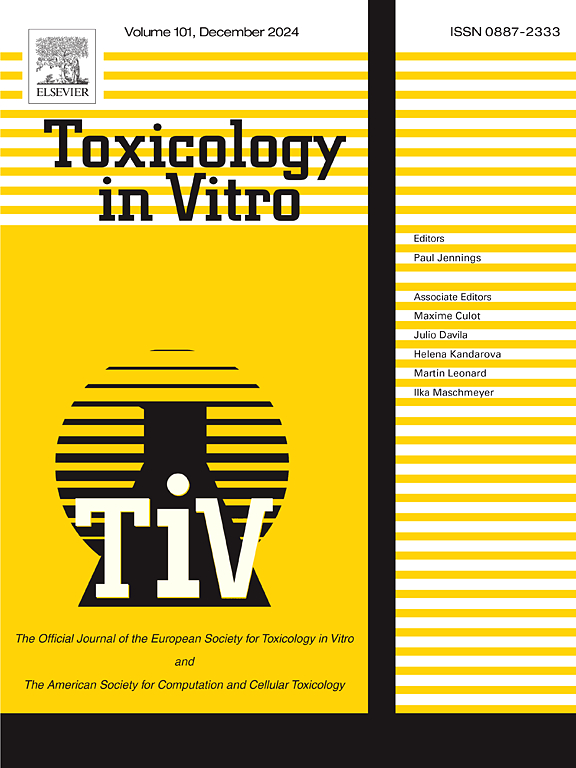In vitro human skin absorption of ethyl salicylate, pentyl salicylate, and (Z)-3-hexenyl salicylate from topical formulations: Effects on permeation and distribution
IF 2.6
3区 医学
Q3 TOXICOLOGY
引用次数: 0
Abstract
In vitro human skin permeation and distribution of the fragrance materials ethyl salicylate (CAS 118–61-6, ES), (Z)-3-hexenyl salicylate (CAS 65405–77-8, HS) and pentyl salicylate (CAS 2050-08-0, PS) from separate 0.5 % (w/w) cream formulations were determined under unoccluded and occluded conditions for 24 h. For PS only, a 0.5 % (w/v) solution in 70/30 (v/v) ethanol/water was also assessed. Consumer relevant finite formulation doses were applied (5 mg/cm2 or 5 μl/cm2) with salicylate application of ∼25 μg/cm2. Although specifically assessing metabolism was not an aim, the common hydrolysis product salicylic acid (SA) was also quantified and included in overall test compound absorption values.
For ES, absorbed doses (mean ± standard error, SE) were 12.0 ± 1.0 and 24.7 ± 1.3 % applied dose under unoccluded and occluded conditions, respectively. For HS these values were 7.28 ± 0.52 and 11.1 ± 0.7 % applied dose. For the PS cream, corresponding values were 4.43 ± 0.48 and 7.52 ± 0.63 % applied dose. Whilst for the PS solution values were 8.26 ± 0.31 and 16.1 ± 0.7 % applied dose. The salicylate structure, application vehicle and level of occlusion impacted on the observed skin absorption. Considering salicylates are commonly used fragrance ingredients and have limited skin absorption data, the current research will be helpful in risk assessment to determine systemic exposure that is realistic and fill data gaps.
外用制剂中水杨酸乙酯、水杨酸戊酯和水杨酸(Z)-3-己烯酯的体外人体皮肤吸收:对渗透和分布的影响
在无封闭和封闭条件下,体外 测定了不同的0.5 % (w/w)乳膏配方中水杨酸乙酯(CAS 118-61-6, ES)、(Z)-3-己烯水杨酸酯(CAS 65405-77-8, HS)和水杨酸戊酯(CAS 2050-08-0, PS)的皮肤渗透和分布。对于仅PS, 0.5 % (w/v)的70/30 (v/v)乙醇/水溶液也进行了评估。应用消费者相关有限配方剂量(5 mg/cm2或5 μl/cm2),水杨酸盐应用~25 μg/cm2。虽然具体评估代谢不是目的,但常见的水解产物水杨酸(SA)也被量化并包括在总体测试化合物吸收值中。对于ES,未封闭和闭塞条件下的吸收剂量(平均 ± 标准误差,SE)分别为12.0 ± 1.0和24.7 ± 1.3 %。HS值分别为7.28 ± 0.52 %和11.1 ± 0.7 %。PS乳膏的对应剂量为4.43 ± 0.48 %和7.52 ± 0.63 %。PS溶液的应用剂量分别为8.26 ± 0.31 %和16.1 ± 0.7 %。水杨酸盐的结构、应用载体和闭塞程度影响观察到的皮肤吸收。考虑到水杨酸盐是常用的香料成分,而皮肤吸收数据有限,本研究将有助于风险评估,以确定现实的全身暴露,填补数据空白。
本文章由计算机程序翻译,如有差异,请以英文原文为准。
求助全文
约1分钟内获得全文
求助全文
来源期刊

Toxicology in Vitro
医学-毒理学
CiteScore
6.50
自引率
3.10%
发文量
181
审稿时长
65 days
期刊介绍:
Toxicology in Vitro publishes original research papers and reviews on the application and use of in vitro systems for assessing or predicting the toxic effects of chemicals and elucidating their mechanisms of action. These in vitro techniques include utilizing cell or tissue cultures, isolated cells, tissue slices, subcellular fractions, transgenic cell cultures, and cells from transgenic organisms, as well as in silico modelling. The Journal will focus on investigations that involve the development and validation of new in vitro methods, e.g. for prediction of toxic effects based on traditional and in silico modelling; on the use of methods in high-throughput toxicology and pharmacology; elucidation of mechanisms of toxic action; the application of genomics, transcriptomics and proteomics in toxicology, as well as on comparative studies that characterise the relationship between in vitro and in vivo findings. The Journal strongly encourages the submission of manuscripts that focus on the development of in vitro methods, their practical applications and regulatory use (e.g. in the areas of food components cosmetics, pharmaceuticals, pesticides, and industrial chemicals). Toxicology in Vitro discourages papers that record reporting on toxicological effects from materials, such as plant extracts or herbal medicines, that have not been chemically characterized.
 求助内容:
求助内容: 应助结果提醒方式:
应助结果提醒方式:


